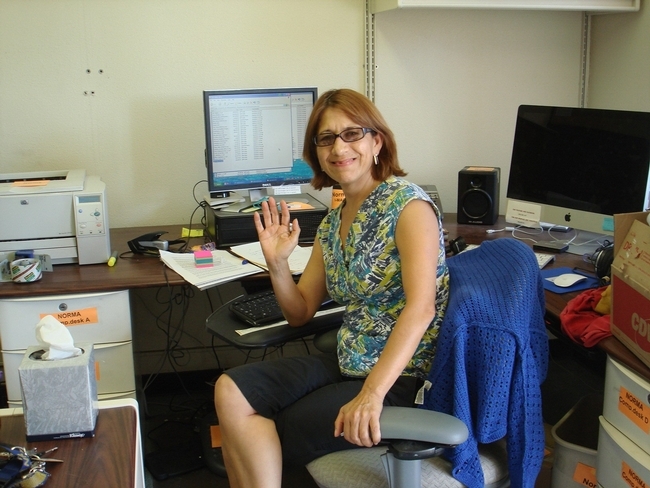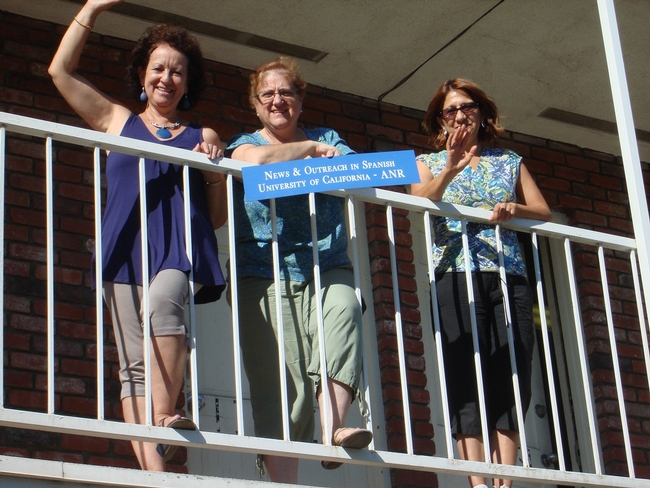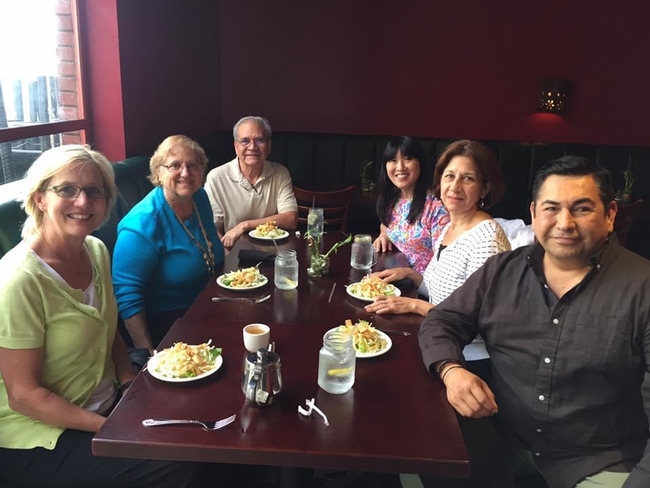- Author: Saoimanu Sope
After 13 years of telling the UC ANR story through written articles and video production, Norma De la Vega retired on June 29. De la Vega joined UC ANR's News and Information Outreach in Spanish team in 2009 as a senior writer.
NOS fulfilled UC ANR's vision of developing educational and informational programs in Spanish to serve the Latino community. For more than 40 years, NOS has been producing information formatted for radio, television, and online audiences, and De la Vega has played an instrumental role in helping NOS expand its reach and diversify its creative approach to storytelling.
When she started, most of her writing focused on nutrition, highlighting groups like the Expanded Food and Nutrition Education Program and the Nutrition Policy Institute. “Norma's contributions were spot on,” said NOS Program Manager Ricardo Vela. “Her impact has been bringing the importance of nutrition into the stories that we bring to the community.”
De la Vega earned a bachelor's degree in science communications from Universidad Nacional Autónoma de México in her hometown of Mexico City. “Learning how to produce videos when I went to school was very different than now,” said De la Vega. “We didn't have the kind of cameras we do today.”
Following college, De la Vega worked as a television reporter in Tijuana before moving to San Diego County where she started focusing on writing. Prior to UC ANR, De La Vega worked as a writer for the Enlace Union-Tribune's Spanish newspaper in San Diego for nearly a decade.
Before it became NOS' primary medium for storytelling, De la Vega helped lead the team's video production effort despite her limited experience. “We weren't experts, but we realized the importance of video production to get our information out. It was a team effort,” she said.
In 2010, De la Vega wrote a story and produced a video on the importance of planning for old age. In many cases, adult children had to manage their parent's care without guidance, and most caregivers of the elderly spoke Spanish as their first language and needed more resources to do a better job.
De la Vega's story relied on research conducted by Patti Wooten Swanson, UCCE nutrition, family and consumer science advisor in San Diego. Not only was Swanson honored at the 2013 Galaxy Awards for her contribution to the story, but De la Vega, a member of the NOS team at the time, won first place at the Western Region Television/Video Communications Award Ceremony despite the lack of a Spanish language category.
In 2016, De la Vega produced a video of the first bilingual 4-H club, the result of a partnership with the Community Settlement Association in Riverside County. “A lot of good things were happening at that time and are happening now because ANR is evolving with more bilingual experts on different topics,” De la Vega said.
Although she started as a senior writer, De La Vega evolved and became a broadcast communications specialist. Her success in the role allowed her to become well-connected to other communicators and community leaders. “Norma always had a contact we needed for a story that we were working on,” said Miguel Sanchez, another broadcast communications specialist on the NOS team.
Lisa Rawleigh, NOS administrative assistant, established a personal and professional relationship with De la Vega. “Norma ensured that our Spanish articles were written properly and that we did not miss any accents or typos. I can always count on her to proofread my posts on social media,” said Rawleigh.
De la Vega said that she feels “enormously satisfied” to have worked with a team of fellow pioneers. “Although we were not experts, we learned so much every day and together,” De la Vega said. “Today, there are several experts in the production of community videos, and we helped enrich the graphic archive for UC ANR's community programs. I think our contribution was to lead the way in that direction.”
Looking ahead, De la Vega will be spending her retirement traveling and exploring other countries and cultures. Since she was a girl, De la Vega enjoyed swimming and can't wait to do more of it. “I love to swim because being in the water always makes me feel young,” she said.
Finally, De la Vega will enjoy quality time with her grandchildren, teaching them Spanish and volunteering at the Spanish immersion school they attend.
To read this story in Spanish, visit https://ucanr.edu/blogs/blogcore/postdetail.cfm?postnum=57440.
- Author: Jeannette E. Warnert

To introduce more valley farmers to the benefits of conservation agriculture practices, Conservation Agriculture Systems Innovation (CASI) produced a six-part documentary featuring California farmers, UC researchers and agency representatives. The series premieres Aug. 6 on the CASI website (http://CASI.ucanr.edu) with a 7-minute segment that lays out the theoretical principles and the scientific basis for conservation agriculture. Additional segments will be released each Monday for five weeks thereafter.
Throughout the series, viewers will meet farmers who are implementing conservation agriculture successfully and profitably on their Central Valley farms. The 6- to 10-minute episodes review the core principles and practices associated with conservation agriculture systems and provide examples of successful local adoption.
After the six-week series airs, viewers, farmers and others interested in conservation agriculture are invited to the UC West Side Research and Extension Center in Fresno County for the annual Twilight Conservation Agriculture Field Day, Sept. 13. The event, which begins at 4 p.m. and concludes when darkness falls, is free and includes a barbecue dinner. Viewers can get clarification on points from the video series and meet many of the farmers and scientists featured in the documentary, plus get a first-hand look at conservation agriculture research currently underway. To register for the Twilight Field Day go to http://ucanr.edu/TwilightRegistration. The West Side Research and Extension Center is at 17353 W. Oakland Ave., Five Points.
“Our goal with the video series is to reach a wider audience of farmers with our research results and on-farm success stories, which show conservation agricultural practices can help make farmers more competitive and sustainable in the long run,” said Jeff Mitchell, UC Cooperative Extension specialist in the Department of Plant Sciences at UC Davis.
The Conservation Agriculture Systems Innovation documentary series includes the following episodes:
Aug. 6: “Introduction to conservation agriculture” – The first video defines conservation agriculture and outlines its increasing credibility in the global context.
Aug. 13: “Maintaining crop residues” – California farmers have tended to adopt “clean cultivation” systems, but research has shown that maintenance of residues from the previous crop or a winter cover crop helps improve soil and reduces evaporation from the surface.
Aug. 20: “Conservation agriculture in tomato production systems” – These systems cut production costs, reduce dust emissions and store more carbon in the soil.
Aug. 27: “Conservation agriculture in dairy silage production systems” – Three dairy farmers committed to conservation agriculture systems in their silage production share their secrets and success.
Sep. 3: “Minimum tillage systems” – This video features examples of a number of reduced pass or ‘pass combining’ tillage systems that have been developed during the past decade.
Sep. 10: “Coupling conservation tillage with overhead irrigation” – Overhead irrigation systems, such as center pivots, are particularly useful when coupled with conservation tillage.
For more information, contact Mitchell at (559) 303-9689, jpmitchell@ucdavis.edu.





